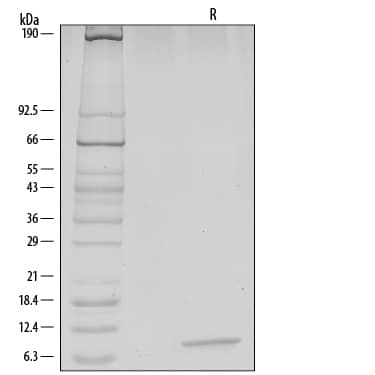Recombinant Human/Rhesus Macaque/Feline CXCL12/SDF-1 alpha Best Seller
R&D Systems, part of Bio-Techne | Catalog # 350-NS

Key Product Details
Product Specifications
Source
Lys22-Lys89
Purity
Endotoxin Level
N-terminal Sequence Analysis
Predicted Molecular Mass
SDS-PAGE
Activity
The ED50 for this effect is 3-9 ng/mL.
Measured by its ability to chemoattract BaF3 mouse pro-B cells transfected with human CXCR4.
The ED50 for this effect is 0.15-0.6 ng/mL.
Reviewed Applications
Read 4 reviews rated 4.8 using 350-NS in the following applications:
Scientific Data Images for Recombinant Human/Rhesus Macaque/Feline CXCL12/SDF-1 alpha
Recombinant Human/Rhesus Macaque/Feline CXCL12/SDF-1 alpha Bioactivity
Recombinant Human/Rhesus Macaque/Feline CXCL12/SDF-1 alpha (Catalog # 350-NS) chemoattracts the BaF3 mouse pro-B cells transfected with human CXCR4. The ED50 for this effect is 0.15-0.6 ng/mL.Recombinant Human/Rhesus Macaque/Feline CXCL12/SDF-1 alpha SDS-PAGE
1 μg/lane of Recombinant Human/Rhesus Macaque/Feline CXCL12/SDF-1 alpha was resolved with SDS-PAGE under reducing (R) conditions and visualized by silver staining, showing a single band at 7 kDa.Formulation, Preparation and Storage
Carrier Free
What does CF mean?CF stands for Carrier Free (CF). We typically add Bovine Serum Albumin (BSA) as a carrier protein to our recombinant proteins. Adding a carrier protein enhances protein stability, increases shelf-life, and allows the recombinant protein to be stored at a more dilute concentration. The carrier free version does not contain BSA.
What formulation is right for me?In general, we advise purchasing the recombinant protein with BSA for use in cell or tissue culture, or as an ELISA standard. In contrast, the carrier free protein is recommended for applications, in which the presence of BSA could interfere.
Carrier: 350-NS
| Formulation | Lyophilized from a 0.2 μm filtered solution in Acetonitrile and TFA with BSA as a carrier protein. |
| Reconstitution | Reconstitute at 100 μg/mL in sterile PBS containing at least 0.1% human or bovine serum albumin. |
| Shipping | The product is shipped at ambient temperature. Upon receipt, store it immediately at the temperature recommended below. |
| Stability & Storage | Use a manual defrost freezer and avoid repeated freeze-thaw cycles.
|
Carrier Free: 350-NS/CF
| Formulation | Lyophilized from a 0.2 μm filtered solution in Acetonitrile and TFA. |
| Reconstitution | Reconstitute at 100 μg/mL in sterile PBS. |
| Shipping | The product is shipped at ambient temperature. Upon receipt, store it immediately at the temperature recommended below. |
| Stability & Storage | Use a manual defrost freezer and avoid repeated freeze-thaw cycles.
|
Background: CXCL12/SDF-1 alpha
SDF-1 alpha and SDF-1 beta are the first cytokines initially identified using the signal sequence trap cloning strategy from a mouse bone-marrow stromal cell line. These proteins were subsequently also cloned from a human stromal cell line as cytokines that supported the proliferation of a stromal cell-dependent pre-B-cell line.
SDF-1 alpha and SDF-1 beta cDNAs encode precursor proteins of 89 and 93 amino acid residues, respectively. SDF-1 alpha and SDF-1 beta are encoded by a single gene and arise by alternative splicing. The two proteins are identical except for the four amino acid residues that are present in the carboxy-terminus of SDF-1 beta and absent from SDF-1 alpha. The amino acid sequence of SDF-1/PBSF identified the protein to be a member of the chemokine alpha subfamily that lacks the ELR domain. Unlike other known chemokine alpha and beta subfamily members that cluster on chromosomes 4 and 17, respectively, SDF-1/PBSF was mapped to chromosome 10q11.1. SDF-1/PBSF is highly conserved between species, with only one amino acid substitution between the mature human and mouse proteins. SDF-1/PBSF has been found to be a chemoattractant for T-lymphocytes and monocytes, but not neutrophils. SDF-1/PBSF was shown to be a ligand for CXCR4 (fusin/LESTR) receptor that functions as a co-receptor for lymphocyte-tropic HIV-1 strains. SDF-1/PBSF has been found to be a powerful inhibitor of infection by lymphocyte-tropic HIV-1 strains.
References
- Tashiro, K. et al. (1993) Science 261:600.
- Bleul, C. et al. (1996) Nature 382:829.
- Oberlin, E. et al. (1996) Nature 382:833.
Alternate Names
Gene Symbol
UniProt
Additional CXCL12/SDF-1 alpha Products
Product Documents for Recombinant Human/Rhesus Macaque/Feline CXCL12/SDF-1 alpha
Product Specific Notices for Recombinant Human/Rhesus Macaque/Feline CXCL12/SDF-1 alpha
For research use only

